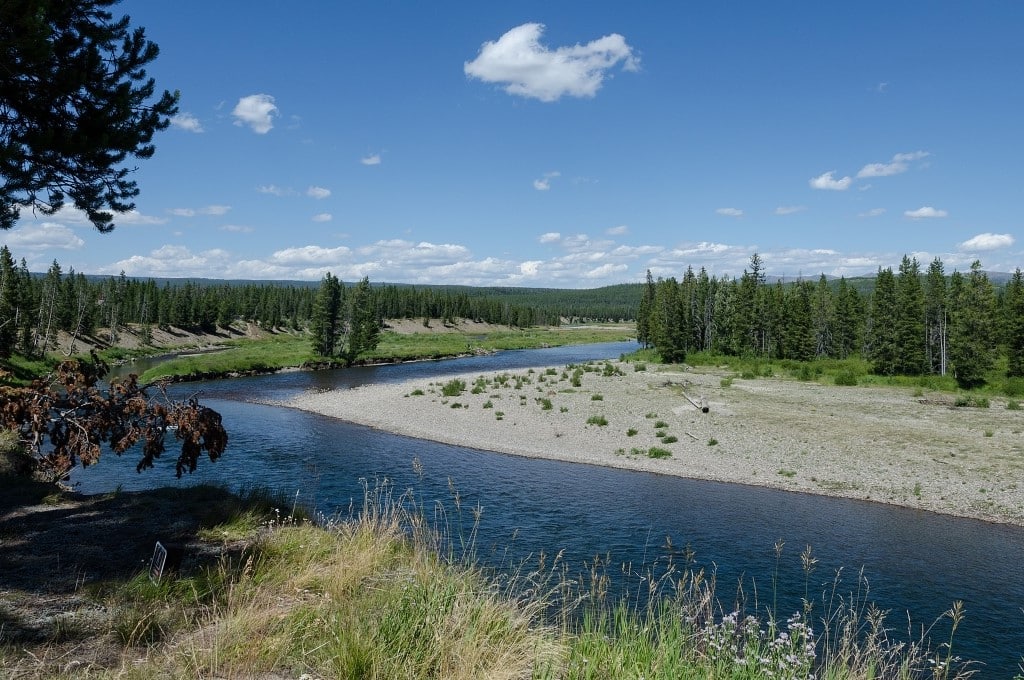Originating in Yellowstone National Park, the Snake flows south through Jackson Hole before it heads west into Idaho. Along the way, it gathers waters from major tributaries including the Gros Ventre, the Hoback, and the Greys.
A good portion of all these waters is open to the public and full of Snake River cuts. I will describe these waters working downstream.
Reaching Snake River
The city of Jackson and the surrounding area which is known as Jackson Hole (WGS84 – N43.47446, W110.76198) is located in the northwest corner of the state.
The Snake River runs south from Yellowstone National Park (WGS84 -N44.13500, W110.18297) through Grand Teton National Park and Jackson and continues south to Alpine, WY.(WGS84 – N43.180003, W111.04424).
Here it enters Idaho and continues thereafter through Idaho, Oregon, and Washington State to empty into the Columbia River after a run of some 1040 miles plus. The article covers just a portion of Wyoming water.
Fish at this Location
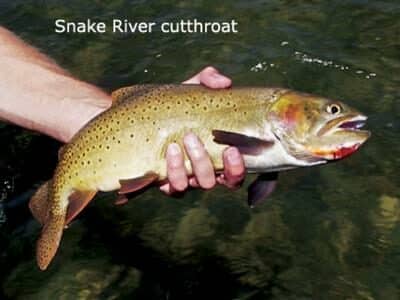
Cutthroats love dry flies. They will come from ten feet down to get at one; smashing it with apparent fear that it will escape! They are special fish. If you love to fish dry flies, there is no better quarry than a wild native cutthroat.
Distinguished by the red slash on their lower jaw that gives them their name, cutthroats are the native trout of the Rocky Mountain west. There are approximately nineteen different varieties, each unique to a particular area or watershed (the classifications are still being debated by scientists).
Some, like the greenback cutthroat, display large black dots and vibrant orange sides. Others, like the Lahontan cutthroat, are more silver with fine spots.
Most varieties are threatened with extinction due to loss of habitat, hybridization with non-native rainbows, and competition from non-native brook trout, browns, and rainbows.
In most of the west, they have been driven from the major waters, holding on only in more isolated backcountry tributaries.
There are a few watersheds where native cutthroats are still the dominant specie. One of the best is the Snake River basin in western Wyoming. If you wish to pursue these native fish in traditional waters, there is no better place than the Snake.
Fishing Snake River
The headwaters of the Snake in Yellowstone National Park offer a relatively easy day hike to excellent cutthroat fishing. This is where it all begins.
The trailhead is near the south entrance to Yellowstone (WGS84 -N44.13629, W11066661). A reasonable hike east will get you to some great small water fishing for Snake River cutthroats. Just downstream (South) from the Yellowstone entrance a road to the West follows the river for a few miles giving some easy access.
As the Snake enters Grand Teton National park, it is dammed to form an expanded Jackson Lake (WGS84 – 43.85742, W110.58975).
The tailwater below the dam offers an excellent opportunity to catch some really nice Snake River cuts. Access is easy via a turnoff from Teton Park Road which crosses the dam.
The tailwater is a fairly swift knee-to-waist deep run. Hatches are possible but I have found deep nymphing and stripping woolly buggers to be most effective.
This is the single most popular spot in the Park to fish the Snake so expect a few anglers. Many fishers use spinning gear and cast spinners and spoons across the current, swinging them in the current.
Still, it is not crowded enough to prevent the occasional moose from ambling across the river or browsing on the shore. Check with the Park for license requirements and current fishing regulations and closures.
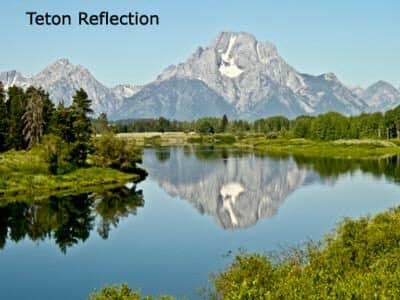
Between the dam and Jackson Hole, the Snake becomes a wide braided river. This is a popular area to float.
You probably have seen photos of a drift boat, angler fast into a fish, with towering jagged peaks in the background. Those photos are taken on the Snake in Teton National Park.
Depending on the time of year, fishing could be with a big dry and a dropper or with a two-nymph rig.
As the Snake nears the Idaho border it cuts through the Grand Canyon of the Snake. Here the water is better suited to whitewater rafting than fishing. Some floats include serious whitewater.
If you don’t know the water, hire a guide. Just as it enters Idaho at Alpine Wyoming, the Snake is dammed for the second time to form Palisades Reservoir (WGS84 – N43.18003, W116.04424).
If you float the Snake watch for wildlife and enjoy the great scenery as well as the fishing. There are nine floats between the dam and Palisades Reservoir. The floats offer access to some exceptional fishing.
Floating down with the current and casting a hopper and dropper to pockets and shoreline structure is often very effective. Mix this with the occasional stop to wade fish a run.
If you are at the right spot at the right time, a hatch will bring a run alive with cutthroats and whitefish. Floating beautiful water running through a scenic valley, and fishing for native cutthroats make this a classic western fly fishing experience.
On one fall float on the lower river, my guide timed our arrival at a long run to meet an afternoon BWO hatch. We anchored and I caught cuts and whitefish on a parachute Adams for two hours.
When the hatch ended, we continued downriver stripping woolly buggers for the big browns that hide under shoreline brush on the lower reaches of the river.
The numerous take-outs along Highway 89 offer access to wade fish the Snake. You may have to search a bit to find water that holds trout, but when you do it is not uncommon to catch a large number of fish.
Standing knee deep at the edge of the river, as I did one fall day, catching fish after fish along a current seam as the sun set and Sandhill cranes flew overhead is the stuff memories are made of.
There are some other areas where wade fishing works. However, the river is big and fast and the bottom is full of rocks that move easily, making wading dangerous in most places.
One of my successful wading experiences was where Highway 22 crosses the river west of Jackson (WGS84 – N43.49899, W110.84587). I had good success for trout and whitefish with a deep nymphing rig.
Fishing The Gros Ventre
In my mind, the best wade fishing in the area is in the rivers that feed into the Snake.
Starting from the north below Lake Jackson and working downriver they are the Gros Ventre (pronounced Gro Vant for reasons only the French understand), The Hoback, and Greys River.
The Gros Ventre enters the Snake from the east above Jackson. The lower portion, from the highway to the town of Kelly (Lower Gros Ventre Road ), is mostly on private property with a couple of popular public access areas and a campground. I pass this area to get to the upper river.
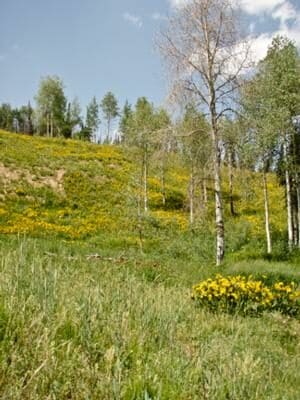
Follow the road as it bends north to a turnoff to the east. The road will take you through a canyon to Lower Slide Lake (WGS84 – 43.63297, W110.52632).
Above Lower Slide Lake most of the water is in Bridger Teton National Forest. Lower Slide Lake was formed by a gigantic landslide when tons of rocks and dirt sloughed off the bluff above the river to form a natural dam.
This geological event was fortuitous for the cutthroats. Cutthroats are nomadic trout. Many move upriver in spring to spawn and then move down to lakes or major rivers for the winter. This means that the river above Lower Slide Lake is full of cutthroats from July through September.
There are many miles of access along the forest road above Lower Slide Lake. This is a beautiful western country. Worth the trip even if you weren’t fishing!
You can drive up almost to the headwater creeks. The road is dirt and often rough but passable for most cars. Hiking trails will take you even further up into the high county. There are enough places to fish to keep any angler happy for weeks.
If you want a hike and great fishing, you can visit the valley my friend Richard and I explored. Between Lower and Upper Slide Lakes, Crystal Creek enters the Gros Ventre from the south.
FR 30377 takes you south along the creek to the trailhead. The trail takes you over a ridge and backs down to the valley and the creek. It is a terrific backcountry day trip.
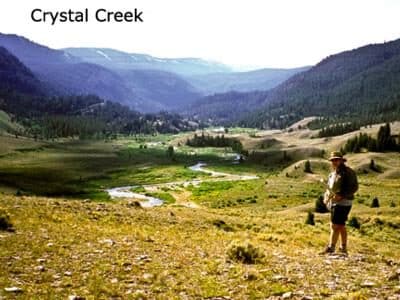
One day while Richard and I explored the stream, a blue wing olive hatch brought the trout to the surface. They were everywhere. In the riffles. In the pools. One pool had several large fish rising.
When I hooked the first one I was surprised to land a 16-inch rainbow. It was followed by three others of equal size. These were the only rainbows I have caught above Lower Slide Lake.
I hope they remain that scarce as these fish will hybridize with the cutthroats.
Fishing Flat Creek
Just above the town of Jackson in the National Elk Refuge is Flat Creek (WGS84 – N43.48989, W110.76262).
This little creek is the main spawning area for Snake River Cutthroats who journey up from the Snake each spring.
The creek has been improved by Trout Unlimited volunteers as well as others and is closed during the spawning season. It is open only from August 1st to October 31st.
Summer and early fall offer some great fishing. There are deep undercut banks where a dry and dropper can work wonders. However, these are educated trout and some days they will drive you nuts.
A nice big 16 incher will rise continually yet ignore your perfectly good imitation as if it were the worst fly in the world. But if you hit it right, this place is magical.
Fishing The Hoback River
At Hoback Junction, another major tributary, the Hoback River, enters the Snake from the east.
Highway 189 (WGS84 – N43.32150, W110.73172) follows the river upstream through Hoback Canyon. Here you will find numerous public access points that offer some great fishing.
Near Bondurant, the highway leaves the river which comes in from the south. South of Bondurant, the river traverses private property in a big open valley accessed by a dirt road.
Fortunately, the Jackson Fork Lodge offers great accommodations and access to miles of excellent cutthroat fishing on its property in the valley. It also grows rare white buffalo.
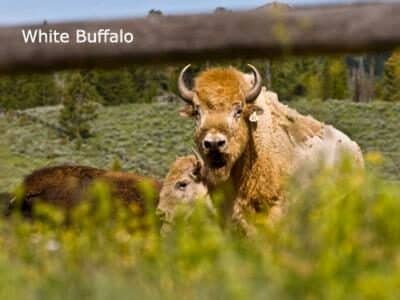
Upstream from the Lodge, the headwaters of the Hoback are on National Forest land with easy road access. In July, this road is bordered by a profusion of spectacular wildflowers.
Snake River cuts are nomadic, traveling upriver to spawn and then slowly working their way back down the river into a bigger river, in this case, the Snake, over the summer.
As a consequence, water that fished wonderfully last year or even last week will seem completely devoid of fish now. My best advice is to sample areas until you find where they are hiding.
The stretch through the canyon is punctuated with long runs and riffles that drop into deep pools.
Most of the summer an attractor dry and a nymph dropper work wonders once you find the fish. Wade this river carefully as the current is often faster than you expect and the bottom can be slippery.
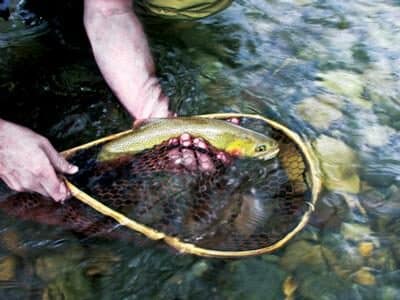
There are two tributaries to the Hoback that I fish and that can be very productive. When the nomadic trout leave the area, resident trout stay. Granite Creek enters from the north.
Follow Granite Creek road toward Granite Falls. A beautiful open valley offers excellent fishing in riffles and pools. You could easily spend two or more wonderfully productive days here without fishing the same water twice.
Further up the Hoback, Cliff Creek enters from the South. This is a smaller stream that offers a large population of willing smaller Snake River cuts, all looking for their favorite dry fly.
They smash anything in the neighborhood. I always end up spending a day or two here.
Fishing Greys River

The Grey, which enters the Snake at Alpine Junction, (WGS84 – N43.16635, W111.00566) offers excellent backcountry cutthroat fishing.
Follow FR10136 southeast from Alpine. You will find many miles of access in the National Forest as well as several forest service campgrounds.
The character of the water changes from a fairly large swift stream near Alpine to a small creek as the road takes you up into the high country.
You will have no problem finding the type of water you prefer to fish in. All of it contains native Snake River cutthroats anxious to take a dry fly. Unfortunately, brook trout are dominant in the high country tributaries.
Seasons and Regulations
The Snake River basin is open to fishing all year. However, during the winter months, catch-and-release regulations are in effect. From April 1st to October 31st slot limits are in effect.
These limits vary by location so if you plan to keep a trout or two, make sure you know the rules for the water you are fishing. I strongly urge that, if you keep a fish, make it a non-native rainbow, brown, or brook.
Spring comes late here so April and May are cool. Runoff lasts into July. Fall starts in September and snow is typical by late November.
The best time to fish is July through September. I never get tired of it and I still have not come close to covering all the fishable water.
Just looking at the DeLorme map to see all the smaller tributaries that probably go unfished, I am already planning my next pursuit of the Snake River cut. So much water…so little time! It is enough to make a trout bum out of anyone.
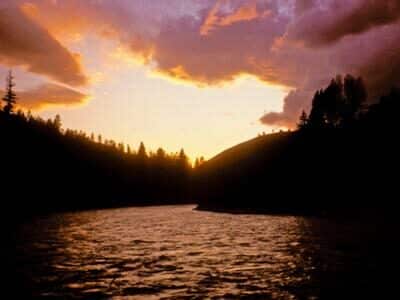
Tackle and Techniques
The most common method of fishing for the trout in this river system is with a fly rod. A 5wt is the most you will need. Two fly nymphing setups, dry and dropper, and streamer are the techniques used.
Stimulators are commonly used as the dry so anything less than 5wt could have trouble handling these big flies in the Wyoming wind.
Final Words
Well, there you have it. Miles and miles of great water flowing through classic western scenery. All of it full of native Snake River cutthroats.
The Snake is a big river that is not easily waded in most places. It is 80 miles long here. The side streams are of medium size, mostly wadable if care is taken in the swift current. They total over 80 miles in length from Yellowstone headwaters to the Palisades Reservoir.
Fishing is open year-round but some sections have special regulations regarding techniques and time of year to fish. If you are intending to keep any trout, check to make sure it is legal where you are fishing. You are strongly urged to release any cutthroats you catch.

